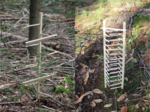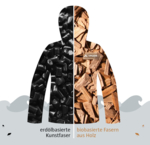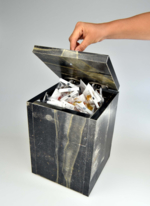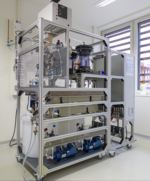Biobased resources
A major goal of the bioeconomy is to use larger quantities of biobased raw materials to produce energy, transport fuels and feedstock for industrial processes. This requires detailed analyses, simulations, concepts and processes. Major focus needs to be placed on issues relating to crop production, biomass potentials, land surface requirements, conversion technologies, biobased value creation networks and food security. Agriculture, forestry, waste management and the industry in general will need to work in concert as far as the raw materials all of them use or deal with are concerned.
-
Natural fibers in use - 15/02/2022

Ansmann AG from Assamstadt provides mobile energy solutions with a focus on sustainability. The BioBattery project, which was awarded the Baden-Württemberg Bioeconomy Innovation Prize, saw Ansmann AG working with the Fraunhofer LBF in Darmstadt to develop a natural fibre reinforced plastic composite for use in e-bike battery cases.
-
Protection against game damage - 13/01/2022

Young forest plants need protecting against damage and as a result it’s often hard to miss the colourful plastic tree guard sleeves when out walking in forests. These tree guard sleeves are neither pleasing to the eye nor sustainable. Bernd Schairer UG from Albstadt has developed sapling protectors made of wood that contain no plastics, metals or chemicals, do not require removal and disposal, and are produced in a socially responsible way.
-
Plant residues - 14/12/2021

Straw cannot yet be spun into gold, but in Mannheim, Germany, it is being turned into something else of great value: Essity is the first and only company in Europe to produce toilet paper and kitchen rolls from wheat straw in a new pulp mill. From next year, these sustainable sanitary paper products will be found on supermarket shelves.
-
Renewable raw materials and the circular economy in the textile industry - 08/12/2021

VAUDE develops outdoor gear made from natural or recycled materials that are harmless to people and the environment while protecting against the wind and rain. The company relies on renewable raw materials, biobased plastics and the circular economy.
-
Further utilisation of plant residues - 25/11/2021

Biogas plants produce energy-rich gas by fermenting biomass. This process generates both liquid and solid fibrous and particulate fermentation residues. Researchers at the German Institutes of Textile and Fibre Research (DITF) have now managed to create a resistant and water-repellent fibre composite material from solid hop residues that can be used as a veneer to coat wood panels.
-
Climate-friendly circular economy - 11/11/2021

A Fraunhofer team has successfully produced a dye using CO2 adsorbed from the air. The aim is to move towards a climate- and resource-friendly circular economy. Chemicals, as well as fuels, can be produced cost-effectively using this process. How does the technical process work, and what opportunities does it open up?
-
Upcycling of lignin - 26/10/2021

Extracting vanillin from lignin dissolved in black liquor and developing it into a process that can be scaled up for industry is a bioeconomic approach that researchers at Biberach University of Applied Sciences and Ulm University are pursuing in a five-year project.
-
Compostable nappies - 14/10/2021

In an EU-funded project, the Tübingen-based biotech company Novis is working with international partners to develop a fully compostable nappy that contains no plastic parts. This could reduce the huge quantities of used disposable nappies that have been produced to date and the enormous costs of disposal, as well as avoiding the greenhouse gases produced when they are incinerated.
Website address: https://www.biooekonomie-bw.de/en/articles/biobased-resources






